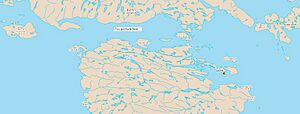Fury and Hecla Strait facts for kids
The Fury and Hecla Strait is a narrow channel of Arctic seawater in Nunavut, Canada. It's like a watery passage connecting two larger bodies of water: the Foxe Basin in the east and the Gulf of Boothia in the west. This strait is found between Baffin Island to the north and the Melville Peninsula to the south.
The water in the strait moves in different directions, sometimes flowing west and sometimes east. This movement is influenced by the tides and other natural forces. The strait also helps drain water from the Arctic Ocean into Hudson Bay through Foxe Basin.
How the Strait Got Its Name
The Fury and Hecla Strait was named after two ships from the Royal Navy: HMS Fury and HMS Hecla. These ships were part of an expedition led by Sir William Edward Parry in 1822.
In October 1821, both ships got stuck in the ice and couldn't move for eight months! During this time, the explorers learned about the strait from the local Inuit people. Two men from the expedition, along with four Inuit, traveled by sled to explore the strait. Captain Parry later joined another trip to see the strait for himself.
Exploring the Strait
Many years later, other ships successfully traveled through the Fury and Hecla Strait.
- In 1948, the USS Edisto and USCGC Eastwind made it across the strait from east to west.
- In 1956, the HMCS Labrador successfully crossed the strait from west to east.
In August 2016, David Scott Cowper and his son, Freddy Cowper, became the first people to sail through the Fury and Hecla Strait from east to west in their boat, M/V Polar Bound. This was part of their successful journey through the Northwest Passage.
The Mystery of "The Ping"
The Fury and Hecla Strait is also known for a strange, unexplained sound called "The Ping." People describe it as unusual noises that scare away sea animals. The Canadian military has been investigating this mystery to find out what causes these sounds.
See also
 In Spanish: Estrecho del Fury y del Hecla para niños
In Spanish: Estrecho del Fury y del Hecla para niños


